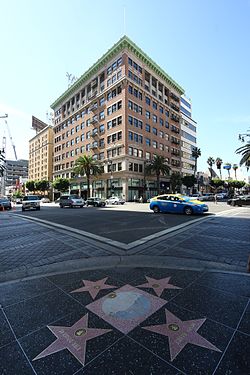Hollywood Boulevard Commercial and Entertainment District | |
 Dyas Bldg. (center), Plaza Hotel (left), Hallmark (right), Leed's (far right), and Palmer Building (far right), viewed from the northeast corner of Hollywood and Vine, 2016 | |
| Location | 6200–7000 Hollywood Boulevard, Vine Street, Highland Avenue, and Ivar Street in Los Angeles, California |
|---|---|
| Coordinates | 34°06′06″N 118°19′58″W / 34.10167°N 118.33278°W |
| Area | 56 acres (23 ha) |
| Architect | Multiple |
| Architectural style | Primarily: Classical Revival Spanish Colonial Revival Art Deco Also: Châteauesque Programmatic Vernacular Victorian International |
| NRHP reference No. | 85000704[1] |
| Added to NRHP | April 4, 1985 |
The Hollywood Boulevard Commercial and Entertainment District is a historic district that consists of twelve blocks between the 6200 and 7000 blocks of Hollywood Boulevard in Los Angeles, California. This strip of commercial and retail businesses, which includes more than 100 buildings, is recognized for its significance with the entertainment industry, particularly Hollywood and its golden age, and it also features the predominant architecture styles of the 1920s and 1930s.[1]
Development of the area that would become the Hollywood Boulevard Commercial and Entertainment District began in the 1880s, when several developers recognized the area's potential for entertainment and the arts. The neighborhood was connected by rail to Los Angeles in 1887, Paul de Longpré built its first tourist attraction in 1901, and the entire area was annexed into the city of Los Angeles in 1910.[2]
Most of the Hollywood Boulevard Commercial and Entertainment District was built between 1915 and 1939, during the rapid boom of the film industry. Three commercial centers rose and expanded until they merged into one, with every major film studio, the industry's most significant talent and advertising agencies, numerous theaters and movie palaces, and other entertainment-related businesses and institutions located in the area.[1][3][4][5] Many of Los Angeles's most notable architects designed the buildings these businesses were in, resulting in a neighborhood filled with significant works, most notably in the Classical Revival, Spanish Colonial Revival, and Art Deco styles.[1]
The neighborhood saw continued success through the 1940s, after which it experienced significant decline.[6] Preservation efforts began in 1980,[7] and in 1985, the entire district was entered into the National Register of Historic Places.[1]
- ^ a b c d e "National Register of Historic Places Inventory Nomination Form - Hollywood Boulevard Commercial and Entertainment District". United States Department of the Interior - National Park Service. April 4, 1985.
- ^ "Early Views of Hollywood (1850–1920)". Water and Power Associates. Retrieved July 23, 2024.
- ^ "The Taft Building". Academy of Motion Picture Arts and Sciences. Retrieved July 23, 2024.
- ^ "Early Los Angeles Historical Buildings (1925 +)". Water and Power Associates. p. 6. Retrieved July 23, 2024.
- ^ Marc Wanamaker. "The Equitable Building of Hollywood". Hollywood Heritage. Retrieved October 3, 2024.
- ^ David Pierson (September 8, 2005). "Some Hollywood Stars Are Fading Away". Los Angeles Times.
- ^ "About Us". Hollywood Heritage. Retrieved July 9, 2024.


